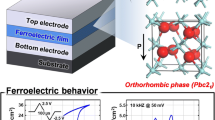Abstract
In this work, we reported improved resistive switching (RS) of SnO2-based resistive random access memory (RRAM) devices according to the post microwave treatment (MWT), working pressures (WP), and the electrode. As a result, as the deposition pressure increased, the operational current of all the devices became commonly lower, and when comparing SnO2 RRAM devices, the optimal RS characteristics are obtained from the sample with Ag top-electrode deposited at WP of 10 mTorr and after the MWT process. The filament was also investigated, for the sample deposited at 5 mTorr, the diameter of the filament was wider in both the high resistive state and the low resistive state as a result of increasing the number of cycles. As a result, the larger the diameter of the filament, the longer the time for the filament formation and rupture was found.





Similar content being viewed by others
References
Hsu C, Wang S, Lin Y, Chen Y (2019) Self-rectifying and interface-controlled resistive switching characteristics of molybdenum oxide. J Alloy Compd 779:609
Prakash R, Kaur D (2017) Bipolar resistive switching behavior in Cu/AlN/Pt structure for ReRAM application. Vacuum 143:102
Kim S, Park B (2017) Unipolar resistive switching characteristics of W/Si3N4/Si memory devices with doped silicon bottom electrodes. J Alloy Compd 17:146
Kim S, Kim M, Kim T, Cho S, Park B (2017) Dopant concentration dependent resistive switching characteristics in Cu/SiNx/Si structure. J Alloy Compd 17:146
Almeida S, Aguirre B, Marquez N, McClure J, Zubia D (2011) Resistive switching of SnO2 thin films on glass substrates. Integr Ferroelectr 126:117
Nagashima K, Yanagida T, Oka K, Kawai T (2009) Unipolar resistive switching characteristics of room temperature grown SnO2 thin films. Appl Phys Lett 94:242902
Hong Y, Wang T, Wei S, Chang P, Yew T (2016) Self-assembled tin dioxide for forming-free resistive random-access memory application. Jpn J Appl Phys 55:060301
Talukdar A, Almeida S, Mireles J, MacDonald E, Pierluissi J, Garcia E, Zubia D (2014) Unipolar resistive switching and current flow mechanism in thin film SnO2. TechConnect Briefs 3:33
Kim H, Yun M, Kim K, Kim S (2016) Oxygen-doped zirconium nitride based transparent resistive random access memory devices fabricated by radio frequency sputtering method. J Alloy Compd 675:183
Kim S, Cho W (2018) Improvement of multi-level resistive switching characteristics in solution-processed AlOx-based non-volatile resistive memory using microwave irradiation. Semicond Sci Technol 3:015009
Kang M, Cho W (2018) Effect of microwave irradiation power on resistive switching performance in solution-processed aluminum oxide resistive memory. J Phys Chem Solids 123:52
Hong S, Kim H, An H, Kim T (2013) Effect of work function difference between top and bottom electrodes on the resistive switching properties of SiN films. IEEE Electron Device Lett 34:1181
Kim S, Kim M, Park B (2017) Understanding reset transitions in Ni/SiNx/Si resistive random-access memory. J Nanosci Nanotechnol 17:7231
Kim S, Cho S, Park B (2016) Sub-100-nA-operating Si-compatible Ni/Ti/HfO2/SiO2/Si RRAM device for high-density integration and low-power applications. J Nanosci Nanotechnol 16:10247
Wu X, Xu Z, Zhao F, Xu X, Liu B, Sun T, Liu S, Zhao W, Ma Z (2014) Transparent bipolar resistive switching memory devices based on Mn doped SnO2 films. J Alloy Compd 602:175
Koval Y, Chowdhury F, Jin X, Simsek Y, Lichtenberg F, Pentcheva R, Müller P (2011) Resistive memory switching in layered oxides: AnBnO3n+2 perovskite derivatives and Bi2Sr2CaCu2O8+δ high-Tc superconductor. Phys Status Solidi A 208:284
Yan H, Li Z (2017) A study on set process and its influence on performance of resistive switching. Phys Status Solidi A 214:1700546
Talukdar A, Almeida S, Garcia E, Mireles J, MacDonald E, Pierluissi JH, Zubia D (2014) Unipolar resistive switching and current flow mechanism in thin film SnO2. TechConnect Briefs 3:33
Akbari M, Kim M, Kim D, Lee J (2017) Reproducible and reliable resistive switching behaviors of AlOX/HfOX bilayer structures with Al electrode by atomic layer deposition. RSC Adv 7:16704
Çaldıran Z, Şinoforoğlu M, Metin Ö, Aydoğan Ş, Meral K (2015) Space charge limited current mechanism (SCLC) in the graphene oxide–Fe3O4 nanocomposites/n-Si heterojunctions. J Alloy Compd 631:261
Acknowledgements
M.J. Yun, D. Bea, J. Jung contributed equally to this work. This research was supported by Basic Science Research Program through the National Research Foundation of Korea (NRF) funded by the Ministry of Education (No. NRF-2020R1F1A1048423) and by Korea Institute for Advancement of Technology (KIAT) Grant funded by the Korea Government (MOTIE) (P0012451, The Competency Development Program for Industry Specialist).
Author information
Authors and Affiliations
Corresponding author
Additional information
Publisher's Note
Springer Nature remains neutral with regard to jurisdictional claims in published maps and institutional affiliations.
Rights and permissions
About this article
Cite this article
Yun, M.J., Kim, K.H., Bea, D. et al. Improved Resistive Switching of SnO2 Based Resistive Random Access Memory Devices Using Post Microwave Treatment. J. Electr. Eng. Technol. 16, 1011–1017 (2021). https://doi.org/10.1007/s42835-020-00633-0
Received:
Revised:
Accepted:
Published:
Issue Date:
DOI: https://doi.org/10.1007/s42835-020-00633-0




